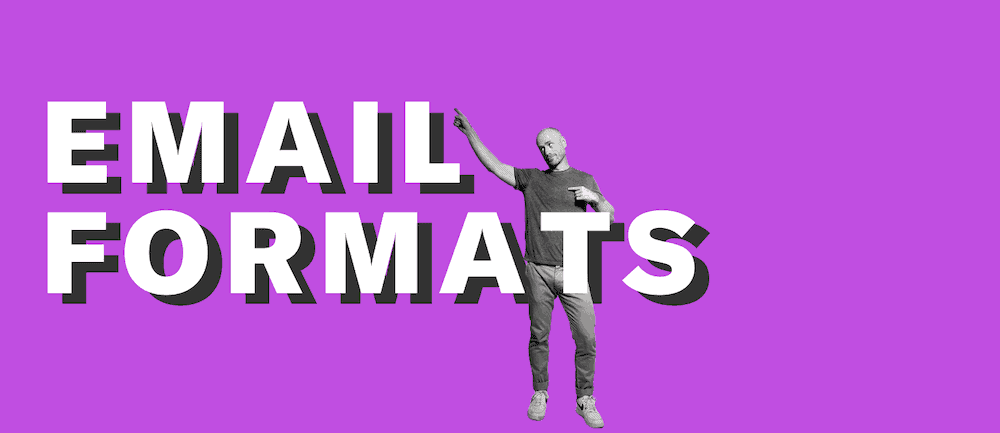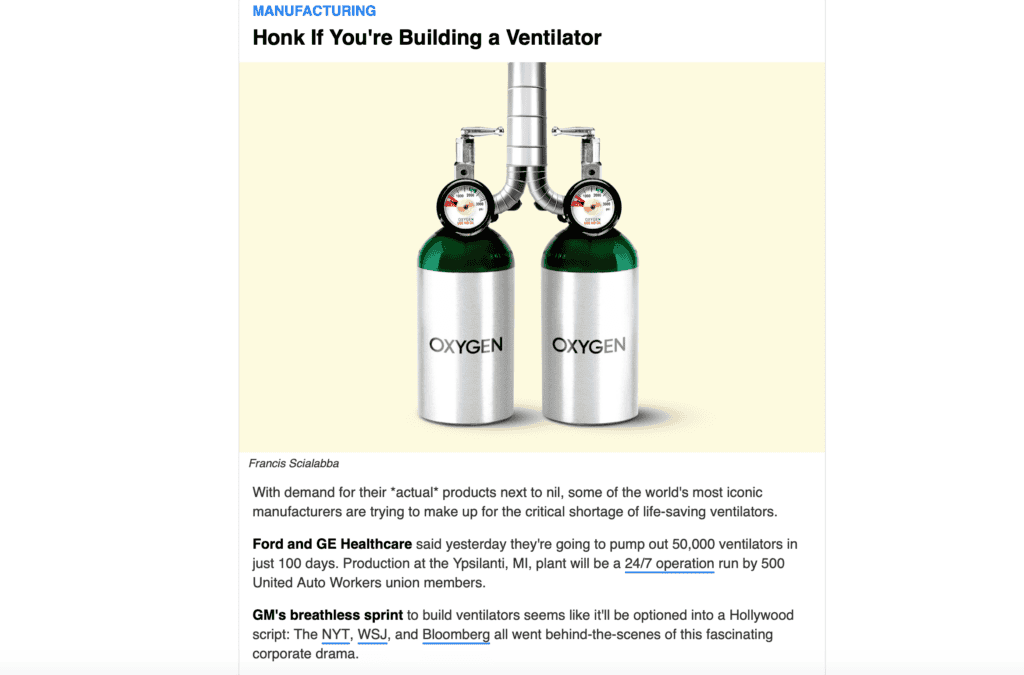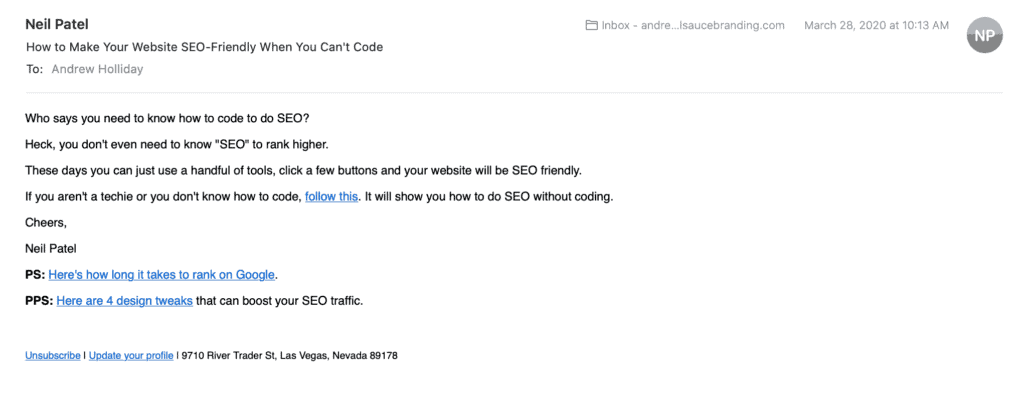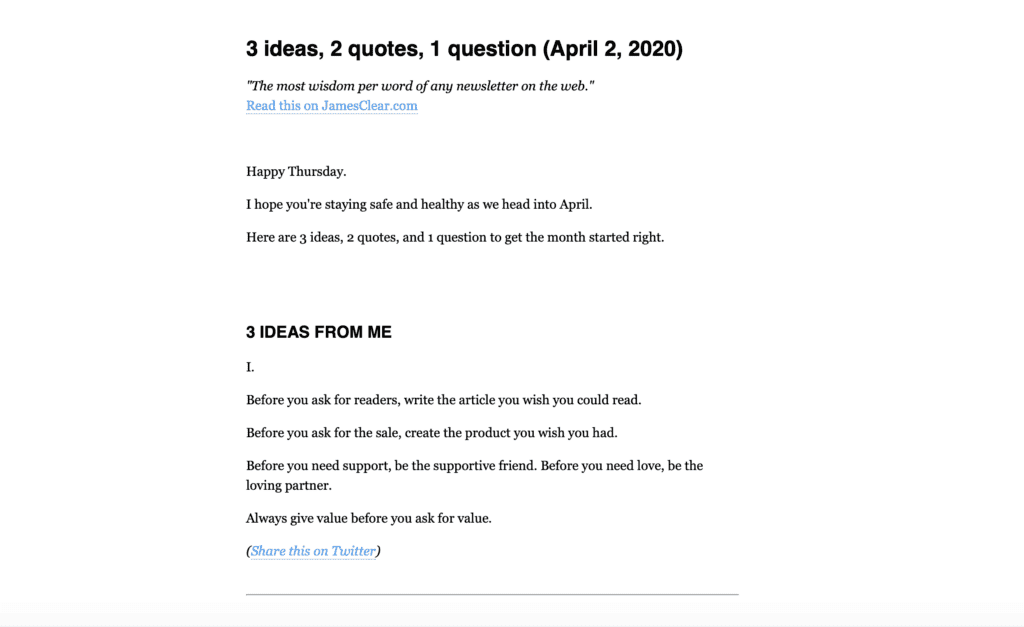
Consistency is a crucial ingredient when baking up an email newsletter. People want to know what they’re getting when they sign up for, open, and read your newsletter. If every email you send is drastically different, you’ll struggle to execute and build a following.
How do you build consistency? First, write your content manifesto. Second, follow an email newsletter format. Let’s take a look at the three primary email newsletter formats that lead to engaged lists.
1. Content Magnifier
This is the strategy most email marketers use. Write blog posts and then share those blog posts through your email with some added commentary to set up each post. Your goal is to get clicks and drive blog traffic.
Positives:
- Less production time for your email thanks to resharing your already developed content.
- Magnifies your blog content (hence the name “Content Magnifier”).
- Patterns readers to click on items in your emails.
- Easier to cover varying thoughts/tips in one email.
Negatives:
- Requires readers to take another step (clicking your links is both positive and negative).
- You must produce quality blog posts every week to power your email.
- It’s hard to stand out when you’re using the same approach as everyone else.
Example of the Content Magnifier email newsletter format.
Neil Patel has mastered the Content Magnifier approach. He puts together a killer blog post, crafts an enticing little teaser, and always serves up value. I open his emails because I know it will lead to learning something. Here’s what Neil Patel’s content magnifier approach looks like…
2. Curation
Read a lot of content, find the good stuff, and share it with your audience. That’s the basic gist of the curation strategy. You’re leveraging the expertise and content of other professionals to offer a “curated” experience for your audience. Your email needs to be carefully researched and highly niched for this approach to work.
The curation strategy is most often used for daily emails and publications. It’s a scalable approach for these organizations pumping out daily content, but you may want to carefully consider before adopting it for a b2b or service business email newsletter.
Positives:
- You’re not depending on producing your own content (articles, videos, podcasts, etc…).
- This strategy mirrors that of a publication and can position your email as a valuable resource for members of your target industry.
Negatives:
- Curation doesn’t show your expertise on a subject.
- It’s harder to build direct trust and drive purchase action for your products and services when always sharing other people’s expertise.
- The purpose of your email is to send people away to other people’s assets.
- It’s a lot harder and more time consuming than you think to source badass content.
Example of the Curation email newsletter format.
I love my daily dose of Morning Brew. They find the most important news of the day and send it to my inbox each morning. Their writing is clever, catchy, and engaging. Here’s a little taste of what you get when you open their email…

3. Digestible Dose
I use this approach for The Recipe, my weekly email. You give a short tip, idea, spark, surprise, or strategy that’s usually served up in the email. Seth Godin and James Clear both use the digestible dose approach as well. The frequency may vary, and sometimes you link out to valuable items, but these are concise emails with a focused lesson or thought in the email. When you do link, your crowd knows it’s important or valuable.
Positives:
- Your community doesn’t have to go through multiple clicks to get to the big payoff, they get immediate exposure to your expertise.
- When you do link to something, your community knows it’s important.
Negatives:
- You don’t get people to your website in every email because you only link out occasionally.
- You must come up with intriguing themes that are on-topic each week to make sure you provide strong value.
Example of the Digestible Dose email newsletter format.
James Clear has mastered this approach. As his email acquisition page boasts,
“The most wisdom per word of any newsletter on the internet.”
I have to agree. Here’s a little taste of what James Clear sends out each Thursday…
Choose wisely, my friend.
The digestible dose fits my style, that doesn’t mean it’s right for you. Your skills may make the curation approach a no-brainer. Find the email newsletter format that fits your personality, strengths, and audience. Once you do, execute consistently. Give people what you promised every single email.
If you’re ready to get serious and create an email newsletter asset to feed your business and grow your brand, you need to check out Inbox Expert.

